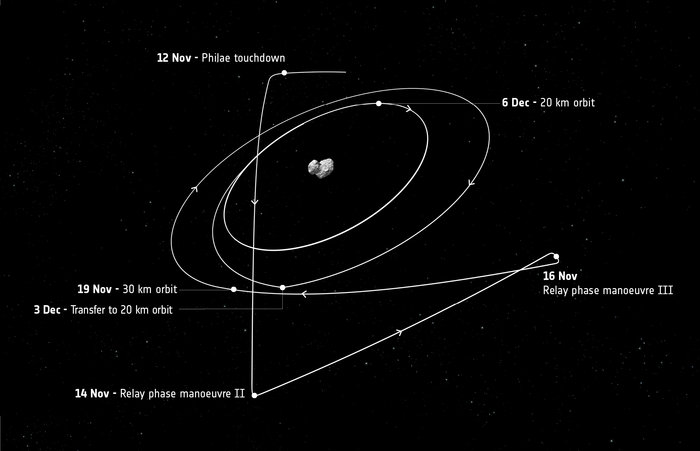You are hereRosetta landing Physics World 2014 Breakthrough of the Year
Rosetta landing Physics World 2014 Breakthrough of the Year
The Physics World, the member magazine of the Institute of Physics has nominated ESA's Rosetta mission as the 2014 Breakthrough of the Year for being the first to land a spacecraft on a comet.
History was made at 15:35 GMT on 12 November 2014 when the Philae module touched down on the surface of 67P/Churyumov–Gerasimenko, a comet 511 million km from Earth and hurtling towards the inner solar system at nearly 55,000 km/h. The module bounced twice before coming to rest, with the vibrations being recorded and transmitted back to earth. It then began collecting data, which was sent back to Rosetta scientists for analysis. The landing followed a seven-hour journey for Philae after it separated from the main Rosetta spacecraft. Launched in 2004, Rosetta itself reached the comet after completing a journey of 6.4 billion km that involved three gravity-assisted fly-bys of Earth and one of Mars.
15:35 GMT on 12 November 2014 when the Philae module touched down on the surface of 67P/Churyumov–Gerasimenko, a comet 511 million km from Earth and hurtling towards the inner solar system at nearly 55,000 km/h. The module bounced twice before coming to rest, with the vibrations being recorded and transmitted back to earth. It then began collecting data, which was sent back to Rosetta scientists for analysis. The landing followed a seven-hour journey for Philae after it separated from the main Rosetta spacecraft. Launched in 2004, Rosetta itself reached the comet after completing a journey of 6.4 billion km that involved three gravity-assisted fly-bys of Earth and one of Mars.
By landing the Philae probe on a distant comet, the Rosetta team has begun a new chapter in our understanding of how the solar system formed and evolved – and possibly how life was able to emerge on Earth. The scientific data that is being collected is the result of a remarkable engineering effort that chased a comet for 10 years and then placed an advanced laboratory on its surface.
The mission was not without its problems. Despite landing in an awkward position where its solar panels do currently not receive enough sunlight to power its instruments, Philae managed to complete all of its planned measurements on battery power alone. The lander was also not able to secure itself to the comet surface as planned, however it did manage to drill into the surface and acquire a sample for analysis.
Organic molecules and dust-covered ice
Preliminary analysis of data sent back from Philae's Cosac instrument suggests that there are carbon-based organic molecules on the comet. This could prove to be very important information for scientists studying conditions on the very young Earth, which is believed to have been regularly bombarded by comets. The lander's Mupus instrument was also able to hammer at the comet's surface, which we now know is covered by a layer of dust about 10–20 cm thick on top of an unexpectedly hard material thought to be water ice, although this is not certain.
The instruments aboard the main Rosetta spacecraft have also made important contributions to our understanding of the solar system. Indeed, scientists using the ROSINA mass spectrometer discovered that the ratio of deuterium to hydrogen in the comet is much greater than that found on Earth. This adds strength to the growing body of evidence that the water on Earth was delivered not by comets, as previously thought, but by asteroids.
An example systems engineering project
While we regularly witness spectacular missions in the space sector (e.g. NASA's Curiosity), these are the result of careful long term planning and well executed systems engineering. What makes the Rosetta mission exceptional is that it was also an example of resilient engineering. Even the launch had to be postponed whereby the originally planned comet was abandoned for a new target. Besides the distance, the voyage took 10 years with a scheduled sleep period of 3 years. Picking up the signal required the largest radio telescope receivers on earth. Yet, the electronics and the software functioned flawlessly.
While many engineers and multiple organisations were involved, this was team work whereby every contribution counts. Our contribution to this mission was to deliver the Virtuoso RTOS that is used in multiple modules on board. Read the articles on the rendez-vous and the successful Philae landing for more details.
As the comet comes closer to the sun, ESA hopes to wake up the Philae lander again in a few months. Meanwhile the Rosetta spacecraft keeps watching over the comet. Stay tuned for more news on this unique event that gives us true insight in what our solar system is really made off. At the same time, we are witnessing that going to space is becoming a more accessible and affordable endeavor. Space-X is one example, but other teams work on small nano-satellites and micro rockets launched from high altitude balloons. Share |
- Printer-friendly version
- Login to post comments